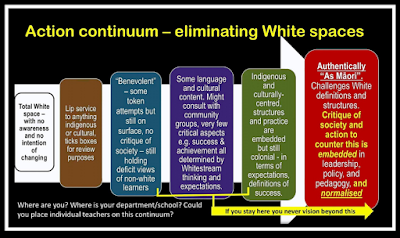This week, I choose Rolfe et al.’s (2001) reflective model, which is based upon three simple questions: What? So what? Now what? This is about the key change in my professional practice.
What?
One
key change in my practice this year is the transforming of my classroom from
traditional to “digital” using Hapara and a range of digital tools. This change has changed my teaching practice and pedagogy
forever. Within the first 16 weeks of the course, I was introduced to
the use of ‘blended learning’ model and ‘gamification’ in the classroom and
that is where I got the idea from. “Blended Learning,” that is, in which students
are mostly learning in the classroom (face-to-face learning) and partially do
online learning off-site. “Gamification” is simply about learning though games.
I am a teacher in a 3:1 device classroom and our school have BYOD open policy
in place due to the limited number of devices available for our students. My
students, in particular, are encouraged to book and use the school’s ICT Room
or the COWs (Computers On Wheels) for their online learning or do it from home.
So what?
I will be using the Cycle of Experiential Learning
(Osterman and Kottkamp’s, 2015) to evaluate the change in my practice.
STAGE 1: Problem Identification
For me as
a teacher, I have always want my students to be successful with their learning.
And to be successful they should be engaged in their learning with a “can do”
attitude and work collaboratively hard, but it was not the case. This year, some
of them were not positive and enthused about their learning.
STAGE 2: Observation and Analysis
Through
my on-going observation and 1:1 conferencing with my students, I have
identified some of them were not enthused about their learning and continuously
disengaged during the lesson. I have come to realisation that “blended
learning’’ and “gamification’’ are the two possible solutions, so I gradually changed
my traditional classroom to digital.
STAGE 3: Abstract re-conceptualisation
“At this point in the cycle, the reflective practitioner engages in an
active search for new ideas and new strategies” (Osterman and Kottkamp, 2015,
p.87). Through Mind Lab, I have learnt about a range of digital tools to be
used in my blended learning and digital (flipped) classroom. During the course,
I have been introduced to numerous of literature about the benefits of blended
learning for my students and myself, as a teacher.
STAGE 4: Active experimentation
Wright
(2010) who found that learning in e-learning environment (i.e. blended
learning) provides collaborative learning opportunities that benefits the
students in both intellectual and social growth. At
the beginning of this implementation I have confronted many challenges: in terms
of digital learning tools; innovative ideas; and time. Within this course, I
have integrated digital learning tools into my “blended learning” and flipped
my classroom digitally. This change has been a great motivation for my students
to engage more with their learning. Students can interact, collaborate, and
support each other. At home, my students are encouraged to virtually
reinforcing what they have learned in class independently. And to see my
students have grown academically and socially is a great feeling indeed.
Now what?
Prior to my
journey with Mind Lab, I was ignorant of digital tools and the new educational
technologies due to my fixed mindset on traditional classroom. Mind Lab have
reminded me about the importance of having a growth mindset especially working
and teaching the students in this digital era. During the course I have managed
to change my classroom and well as my teaching philosophy to suit the needs of
my students. I will continue to collaborate with my other two Mind Lab
colleagues and engage still with the Mind Lab community to ensure that I am up
to date with the digital learning tools in my practice. I am also considering
the idea of keep learning The Mind Lab and do the Master of Contemporary
Education to explore more new ideas and tools to become more and better digital fluent.
References
Bolstad, R. & MacDonald, J.
(2016). An analysis of participant blogs supplemented by teacher interviews.
Wellington: New Zealand Council for Educational Research.
Osterman, K. & Kottkamp, R.
(1993). Reflective Practice for Educators. California. Corwin Press, Inc.
Retrieved from hhttp://www.itslifejimbutnotasweknowit.org.uk/files/RefPract/Osterman_Kottkamp_extract.pdf
Osterman, K. F., & Kottkamp,
R. B. (2015). Reflective practice for educators: professional development to
improve student learning. (2nd ed.) New York: Skyhorse Publishing.
Wright, N. (2010). e-Learning
and implications for New Zealand schools: A literature review. Ministry of
Education.









